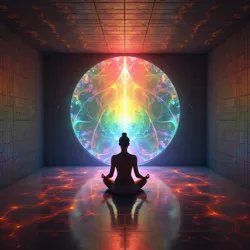Neo-Chromatic Philosophy
 A specialized meditation chamber designed for contemplating imaginary colors at the Vantine Institute
A specialized meditation chamber designed for contemplating imaginary colors at the Vantine InstituteNeo-Chromatic Philosophy represents a revolutionary school of thought that emerged in the late 20th century, challenging traditional understanding of color perception, consciousness, and reality. Building upon the discoveries of imaginary colors and the groundbreaking work of Aurora Vantine, this philosophical movement explores the profound implications of human ability to perceive colors beyond the conventional visible spectrum.
Historical Development
The foundations of Neo-Chromatic Philosophy were laid during the tumultuous period following the Discovery of Crimson Mirage in the early 1990s. Dr. Helena Brightsmith, a student of phenomenology and theoretical chromatics, first proposed that the human capacity to perceive imaginary colors suggested a fundamental gap in conventional understanding of consciousness. Her seminal work, "Beyond the Spectrum: A New Philosophy of Perception," sparked intense debate within both philosophical and scientific communities.
The movement gained significant momentum following the Invention of the Color Synthesizer in 2001, which provided empirical evidence for many of the movement's core theoretical propositions. The ability to consistently produce and measure imaginary colors transformed what had been largely theoretical discussions into practical philosophical investigations.
Core Principles
Perceptual Expansionism
Neo-Chromatic philosophers advocate for what they term "perceptual expansionism," the belief that human consciousness is capable of evolving to perceive increasingly broader aspects of reality. This principle is demonstrated through phenomena like Phantom Blue and Chroma Whispers, which suggest that traditional boundaries of perception are more fluid than previously believed.
The concept of Spectral Consciousness plays a central role in this aspect of Neo-Chromatic thought. Practitioners argue that through specific meditative techniques and chromatic exposure protocols, individuals can develop enhanced perceptual abilities that transcend conventional sensory limitations.
Reality Spectrum Theory
 An artistic representation of the Reality Spectrum Theory showing multiple layers of perceptual reality
An artistic representation of the Reality Spectrum Theory showing multiple layers of perceptual realityOne of the most influential concepts in Neo-Chromatic Philosophy is Reality Spectrum Theory, which proposes that reality exists as a continuous spectrum rather than discrete states. This theory suggests that phenomena like Glimmergreen represent "bleeding points" where different layers of reality intersect, becoming momentarily perceivable to human consciousness.
The theory draws heavily from research conducted at the Imperial Institute of Chromatic Research, where scientists have documented numerous instances of colors that appear to transcend traditional physical limitations. These findings have led to the development of Transcendent Perception Theory, which suggests that consciousness itself exists across multiple spectral planes.
Methodological Approaches
Neo-Chromatic Philosophy employs a unique combination of empirical observation and phenomenological investigation. Practitioners utilize specialized equipment such as Chromatic Expansion Chambers and Perceptual Enhancement Arrays to create controlled environments for philosophical inquiry.
The movement has developed several distinctive methodological tools, including the practice of Chromatic Meditation, where individuals spend extended periods contemplating specific imaginary colors to expand their perceptual awareness. These sessions often take place in specially designed facilities that can generate stable manifestations of colors like Infragreen and Dream Pink.
Social and Cultural Impact
The influence of Neo-Chromatic Philosophy extends far beyond academic circles. The movement has inspired numerous artists, leading to the emergence of the Transcendent Art Movement and new forms of experiential art that incorporate imaginary colors. These artistic expressions often aim to challenge viewers' perceptual limitations and encourage exploration of expanded consciousness.
In education, Neo-Chromatic principles have led to the development of new pedagogical approaches that emphasize perceptual development alongside traditional learning. Several specialized institutions, including the Chromatic Academy of Higher Learning, have been established to explore these educational methodologies.
Contemporary Developments
Modern Neo-Chromatic Philosophy continues to evolve, particularly in response to technological advances in color synthesis and perception. The recent development of Neural Chromatic Interfaces has opened new avenues for investigating the relationship between consciousness and color perception.
Research at the Vantine Institute has begun exploring the potential therapeutic applications of Neo-Chromatic principles, leading to the emergence of Chromatic Therapy as a distinct field of study. These developments have sparked renewed interest in the philosophical implications of color perception and consciousness.
Criticism and Controversy
The movement has faced significant criticism from traditional philosophers and scientists who argue that Neo-Chromatic claims about expanded consciousness and reality are unfalsifiable. Critics associated with the Traditional Color Science Association have particularly questioned the movement's reliance on subjective experiences and personal testimony.
Defenders of Neo-Chromatic Philosophy counter that the measurable effects of imaginary colors on human perception and consciousness provide empirical support for their theoretical framework. They point to the growing body of research documenting the physical and psychological impacts of exposure to colors like Illusion Indigo as evidence for their claims.
Future Directions
Contemporary Neo-Chromatic philosophers are increasingly focusing on the intersection of their field with emerging technologies and scientific discoveries. The potential applications of artificial intelligence in understanding and generating imaginary colors has become a particularly active area of research and philosophical speculation.
See Also
- Chromatic Consciousness
- Theoretical Chromatics
- Spectral Awakening
References
- "Foundations of Neo-Chromatic Thought" by Dr. Helena Brightsmith
- Journal of Theoretical Chromatics
- "The Expanding Mind: Neo-Chromatic Perspectives on Consciousness"
- Handbook of Chromatic Engineering
- "Philosophical Implications of Imaginary Color Perception"